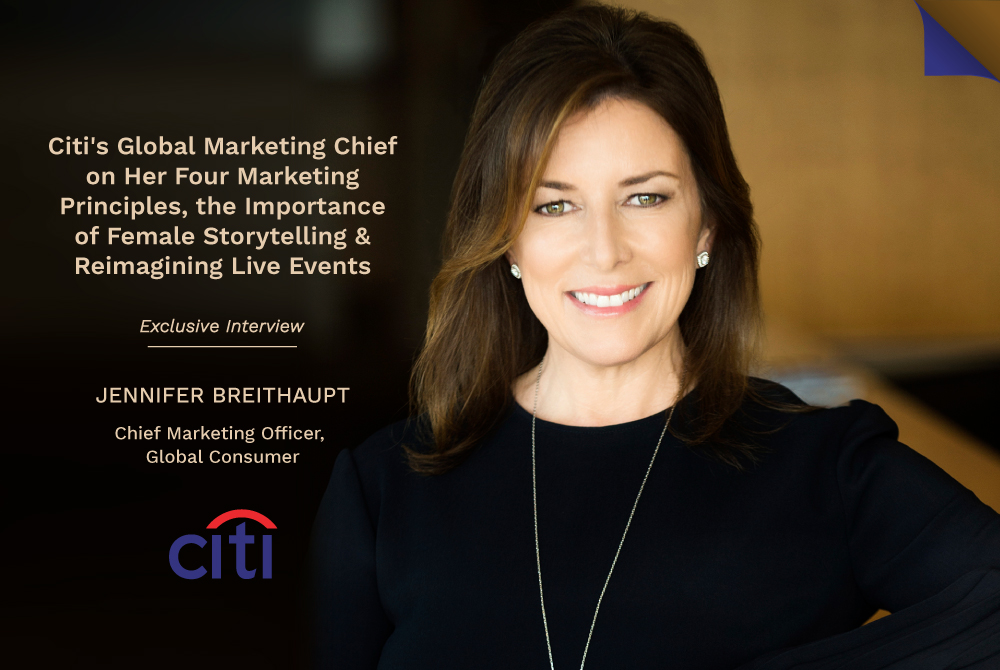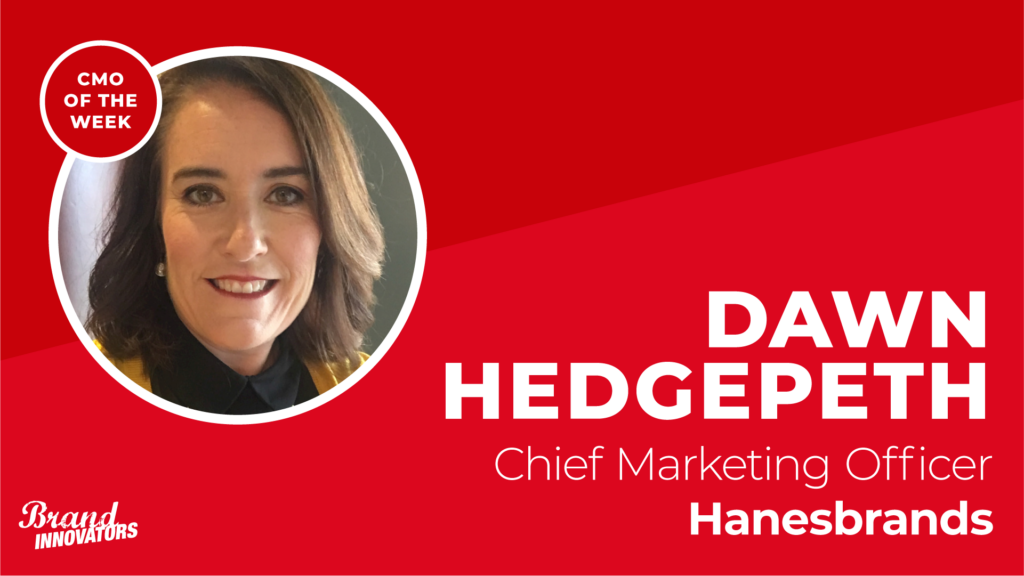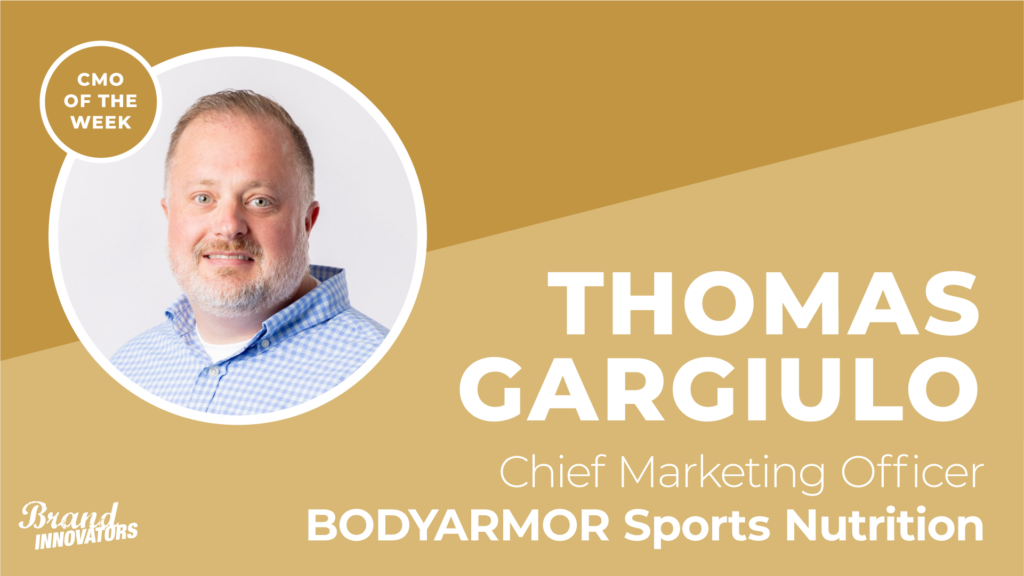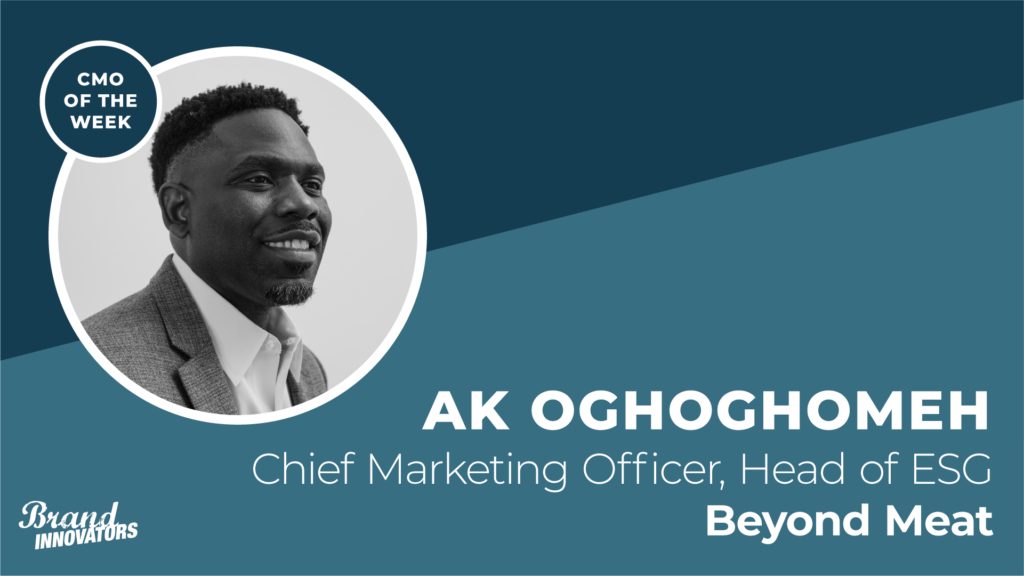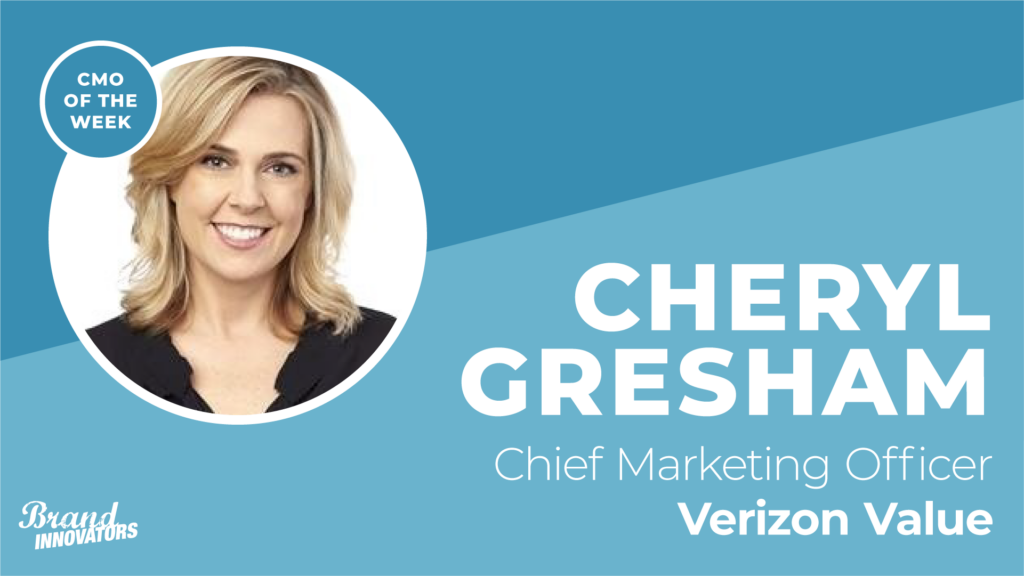As Citi’s Chief Marketing Officer – Global Consumer, Jennifer Breithaupt has helped the financial services company weather a tumultuous 2020 that has included a global pandemic (which first impacted the company’s Asian branch in January), societal unrest in the fight for racial justice and a growing list of local and international crises.
So when Hurricane Isaias struck the Connecticut town where Breithaupt has been quarantining all summer, leaving her and her family without power for more than a week, it was just another unexpected setback that Breithaupt has quickly learned how to navigate.
“You don’t realize how hard it is to do this remote work thing when there’s no power,” says Breithaupt, who was on her eighth consecutive day without power when she spoke with Brand Innovators. “I’m driving around in my car, stealing wifi from the Stew Leonard’s parking lot.”
Connectivity issues aside, Breithaupt has helped Citi stay remarkably productive and ahead of the curve in navigating this new climate from a brand perspective, such as the need for real-time messaging, campaign creative and an empathetic tone. In addition to Breithaupt’s marketing work, the company has been on the leading edge of many philanthropic solutions, COVID-19 relief and diversity efforts. Since global lockdown activity began in early March, Citi has provided $3.3 billion worth of Paycheck Protection Program (PPP) loans to small businesses and $100 million in charitable donations for COVID-19 relief efforts. Citi has also donated $5 million plus a $2 million match donation campaign to longtime charity partners No Kid Hungry to help combat childhood food insecurity during widespread school closures. And after Citi’s CFO Mark Mason, one of the highest-ranking Black executives in consumer banking, penned a heartfelt post for Citi’s blog following the murder of George Floyd in May, Citi contributed more than $10 million in combined donations to four leading civil rights and social justice organizations, plus a colleague donation program where the company will donate up to an additional $2 million to two organizations dedicated to closing the Black achievement gap. “We’re really proud of these efforts to date, and want to do more,” says Breithaupt.
The need for real-time messaging, campaign creative and empathetic tone has completely transformed Breithaupt and Citi’s typical process of year-long planning cycles, which she doesn’t foresee coming back any time soon. “You go from this world where you had all this strategy, and now it’s moved to this world of scenarios – one after the next – to keep up with what’s going on. It’s really changed the way marketers will work in the future as well.”
Beyond her work on national and global brand campaigns, Breithaupt also leads Citi’s expansive music, sports and entertainment strategy, where she’s introduced some innovative new pivots and pilots in the Drive-In events space with partners like Live Nation and New York’s Citi Field until the picture is more clear for live events. (Full disclosure: this reporter has worked with Breithaupt and her teams on entertainment programs in previous roles.)
“It’s been fun to reimagine what experiential marketing looks like,” says Breithaupt, before quickly adding, “Don’t get me wrong, if Foo Fighters were playing a show tonight at Madison Square Garden, that would be amazing. It’s a little hard to replace live. But it’s been a new experience, and one that I don’t think will go away in the future. I think virtual is here to stay.”
Brand Innovators spoke with Breithaupt to learn more about the four guiding principles that have shaped her pandemic marketing strategy, how to remotely create a national ad campaign over the course of one weekend and why Citi’s #SeeHerHearHer initiative for female-driven storytelling in music and advertising has gained momentum in the movement for inclusive creativity. The conversation has been edited for length and clarity.
Brand Innovators: It has been a life-changing past six months for the world, and many marketers have used this time to reconnect with their brand’s core pillars as we move towards a recovery period. What have some of those core pillars been for you and Citi, at a high level?
Jennifer Breithaupt: For us as a global company with clients and employees all around the world, we saw and experienced the effects of the pandemic pretty early here in the U.S. because our counterparts in Asia were going through this ahead of us. But we’ve been around for over 200 years, so we’ve been through some pretty challenging times with our clients and customers globally. And as a business deemed essential, we still have many employees on the frontlines in our bank branches, ATM centers and our call centers taking calls.
So from a very early point, it’s been our goal to align on four key principles. Number one is to keep our people safe and appreciated, since this is a scary and challenging time for them to have to be going out in this. Number two is to help our customers through this and provide relief and help and guidance. Three, it’s been really important for us to be part of the solution which we did very early on. And the fourth one, which sounds bizarre but it was one of our key principles since the beginning, is to plan for a new future. I would say that we still continue to plan on all four key principles, but we’re spending more and more time on the future — how we show up today and how we show up tomorrow, from the products and services we offer, our visual identity, our philanthropy, media considerations, really everything was and is on the table.
Many marketers have told us that the pandemic has rapidly abbreviated 18-month planning cycles into 18 days – if not less. What was the biggest shift for you in terms of timelines to make fast, strategic decisions?
One of the things that will forever change for marketers specifically on the advertising side is the way we produce work. We used to have these lengthy sessions where we brief the agencies, go through concepts for months and then we go do this elaborate film shoot somewhere in the world. Not now. It’s proven that we don’t need to do that now.
For us in late March, early April, we launched an ad spot titled “Gratitude” that really depicted our consumers and our own Citi family. The ad really reflected the recognition for people working tirelessly. The reality with that spot is that it was created over a weekend, which was absolutely unheard of to work on a weekend where you’re using borrowed footage. Some of the people in that spot are actually people who work at our ad agency, Publicis, who had to play roles. It forever changed our willingness to have these really long timelines. It’s made us make really quick decisions.
Citi has historically been one of the biggest sponsors of live entertainment and music for many years now. What’s the role for virtual, remote or socially distanced/drive-in concerts in your strategy until live events can return at scale?
Experiential has been a key component of our overall marketing strategy, but the nature of everything that’s happened has shifted our strategy dramatically over the last few months to protect the health and safety of everyone.
But we continue to work hand in hand with the Live Nations of the world on reimagined events in the near term. One of the things we launched recently was we teamed up to bring to life the first-ever “Live Nation Live From The Drive-In” concert series with Luke Bryan and Darius Rucker, and we will continue to do that. It’s enabled concert goers to tailgate and they’ve done a really nice job of keeping that safe, not like any of the rogue events that you’ve seen out there.
We’ve also continued our eight years and running relationship with Global Citizen and helped them put on their “One World: Together At Home” broadcast in late spring as well as their “Global Goals: Unite For Our Future” event. Both very different in nature, and both really needed and special, so we’ll continue to work in other ways with them.
How have your other live sponsorships, particularly sports, shifted or evolved this year?
We launched in May a reimagined Citi Entertainment site so that it’s Citi Entertainment virtually anywhere and everywhere.We’ve had a ton of different offers from cooking classes to table reads with actors, to sports and tips and tricks from the athletes we worked with.
And last week we hosted our very own drive-in movie experience at Citi Field here in New York. We partnered with Turner Classic Films and every night we had different shows where people could drive up to watch “Casablanca,” “The Wizard Of Oz,” “Wonder Woman” and more classics, so that went really well. And we’ll probably look at doing that in different places with our sport partners, and rethink how we use the venues.
Sports is really interesting. We’ll see how it unfolds in the coming days with college and some of the other leagues. But we’ve been fortunate to have two of our golfers who are excelling in their respective tours. Justin Thomas, who’s one of our athletes, is now No. 1 in the world and another partner Danielle Kang is No. 2 in the world and consistently winning her tournaments. So we’ve been able to take some of our athlete partnerships and create really great content and employee engagement and consumer engagement. We’ll be with Justin when he’s here in New York when he finishes the U.S. Open and capture a ton of content.
But it’s made us reimagine everything. Formula One has been tricky without fans – it’s hard to get those drivers to slow down enough to capture content. But we’ve been fortunate to have our golfers doing well, and again I think with the popularity of virtual events people now realize they can experience anything from the comfort of their homes. But when sports and venues open back up, people are going to flock to them. Nothing replaces that sense of community and shared passion and competition, it’s real and it’s hard to replicate. We’ll continue to be creative with our virtual events and experiences, but when live comes back that will be a game changer.
You founded the #SeeHerHearHer initiative as an extension of the ANA’s #SeeHer campaign. How has that initiative expanded or evolved this year?
The journey continues. I think for us we’re working really closely with the ANA. SeeHerHearHer is a natural extension of See Her because I think it’s really important to not only see women and girls but we need to hear their voices as well. The platform has been since the beginning for all of us – not just a Citi thing – but brands, agencies and the music industry to eliminate gender inequality in the music industry. And when you look at the data, it’s not improving. It’s a real issue. Women still make up 21% of artists, 12% of songwriters and just 2.1% of producers [on the charts]. And at this year’s Grammys, approximately 20% of nominees were female across the top 5 categories and only one woman has been nominated for Producer of the Year in the last eight years. So that just proves women are missing in front of the mic and behind the mic.
I’m so passionate about it because as a marketer I think music is such an important part of storytelling, and it’s a big part of our lives so these numbers just aren’t good enough. I think that we’ve witnessed the power of music in such a profound way over the last six months.It has the power to connect us, heal and unite. I think that not just Citi, but as brands and marketers, the opportunity to give back to the industry we’ve gained so much from is immense.
So we’re continuing to work with the ANA to make sure See Her Hear Her is a movement and not a moment. Earlier this year we teamed up with NBC to rebrand “The More You Know,” their PSA campaign that we changed to “The More You See Her.” We timed all this to International Women’s Day to ensure this was a surround sound campaign. We did press, digital, takeovers of iHeart’s 150+ stations across all their formats and delivered hundreds of millions of impressions. And pre-pandemic in late February we brought together a tremendous group of brands and music industry folks to develop work streams to power the movement. We had such great involvement across categories.
And since then John Nitti [SVP & Chief Media Officer] from Verizon, has come on to co-chair #SeeHerHearHer with me. So we’re really excited, we have a lot of exciting developments to come and we’re really excited to have a collective group of brands involved to put measurement in place and spearhead a bunch of initiatives to actually spark change.
How are you approaching the rest of 2020 from a media mix perspective, given the need for increased flexibility?
It’s been challenging. We’ve shifted a significant amount of our budget to the latter part of the year and that’s just to allow us to appropriately pivot our go-to market approach just to make sure everything resonates within the environment. And we’ll keep working with our partners closely and continue to adapt as needed. But it’s really difficult to predict what the near future looks like. And this fall is a tricky time for marketers, given the election as well. Even the unexpected things that have transpired over the past couple months, it;s a tricky time to think about any kind of integrated plan or approach to it. Our plan for now and I say in the future is around flexibility we just need to move in and out of channels very quickly. So where we appear will continue to evolve, but what I’ve been telling the team and others is focus on what we’re trying to achieve and how to tell the best story. Because it doesn’t matter where you show up if you don’t show up in the right way. So that’s the plan for us right now and as far out as I can see.
Andrew Hampp is an entertainment marketing consultant for Brand Innovators and the founder of consultancy 1803 LLC, based in Berkeley, California.
